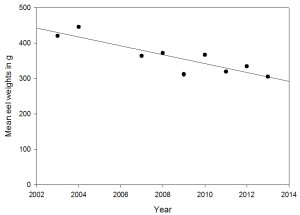IUCN/SSC Otter Specialist Group Bulletin

|
©IUCN/SCC Otter Specialist Group Volume 31 Issue 1 (January 2014) Citation: Kruuk, H. 2014). Otters and Eels: Long-Term Observations on Declines in Scotland. IUCN Otter Spec. Group Bull. 31 (1): 3 - 11 Otters and Eels: Long-Term Observations on Declines in Scotland Hans Kruuk 1 1Formerly Centre for Ecology and Hydrology, Banchory, Scotland |

|
| Received 23rd November 2013, accepted 26th November 2013 |
| Abstract: The summer diet of otters Lutra lutra has been monitored for almost forty years in a study area in NE Scotland. Since 2000, otter numbers and reproduction in the area have declined. At the same time the occurrence of eels (Anguilla anguilla) in otter faeces or ‘spraints’, formerly the otters’ dominant prey, decreased substantially. This is seen against a well-documented sharp, probably global decline in numbers of eel. Otter predation on young water birds in the study area increased, as has predation on other fish species, and changes in importance of other prey are also documented. It is suggested that with otters being food-limited, the decline in eels should be of serious concern to otter conservationists. |
| Keywords: otter; Lutra lutra; eel; Anguilla anguilla; population decline; predation. |
| Française | Español |
INTRODUCTION
Since the 1980s there has been a severe decline in recruitment to populations of eels (Anguilla anguilla) throughout Europe, a decline estimated at over 99% of numbers and continuing ( Stone, 2003 ; ICES, 2012 ). As eels are one of the main foods for Eurasian otters Lutra lutra in many areas, and otter numbers likely to be food dependent ( Kruuk, 2006 ), this is a trend of immediate concern for otter conservation management in Europe. There have been similar declines in eel recruitment in North America and Japan. In early 2013, however, an increase has been observed in numbers of eels in one area in Cambridgeshire, UK ( Anonymous, 2013 ).
It is important to obtain detailed information on long-term changes in abundance of both otters and eels, in order to evaluate ecological impacts and to incorporate such data into management strategies. In one study area in NE Scotland, the Dinnet Lochs where, uniquely, observations have been made on otter ecology over a period of more than 35 years, the opportunity arose to analyse long-term changes in the importance of eels in otter diet, in parallel with approximate observations on otter presence and changes in other prey species.
STUDY AREA AND METHODS
The Dinnet study area is a National Nature Reserve in Aberdeenshire, Scotland, centred on two shallow lakes, Loch Kinord (80 hectares, Ord. Surv. Grid ref. NO441995) and Loch Davan (42 ha., OS grid ref. NJ442018; Fig. 1 ). It has been described earlier by Jenkins (1980) . The lochs are habitat for only a few species of fish (eel Anguilla anguilla, pike Esox lucius and perch Perca fluviatilis), and salmon Salmo salar and trout S. trutta occur in in- and out-flows and in the nearby River Dee. In addition as important potential food species for otter, there are common frogs Rana temporaria and toads Bufo bufo, as well as many water birds.
 |
| Figure 1. The River Dee in NE Scotland, with the Dinnet Lochs, Loch Davan (top) and Loch Kinord (bottom). (click for larger version) |
Visual observations on otters were made usually for several hours in early morning, though for longer times in the 1990s than later on. A measure of foraging efficiency was estimated by timing the period an otter was in the water, and registering the numbers of prey caught.
Earlier studies of otter diet in Dinnet were carried out from the 1970s onwards, starting with Jenkins et al. ( 1979 , 1980 ), various student projects, and Carss et al. (1998) , from whom diet data are quoted to compare with the present study. I observed otter foraging in Dinnet from 1988 onwards, and started faecal (‘spraint’) analysis in Dinnet in 2003. From then on fresh spraints were collected yearly during June, until and including 2013, noting that previous year-round studies had shown that eels were more important in the Dinnet otter food in midsummer, June, than during other months ( Jenkins et al., 1979 , 1980 ). Every year 50 fresh spraints were collected in plastic tubes, 25 from each of the two lochs, and preserved deep-frozen.
For analysis, each spraint was soaked in hot washing liquid, rinsed in a 0.7mm sieve, and the content analysed in a petri-dish, using 2-8x magnification. Fish remains (vertebrae, scales) were identified to species using collected specimens for comparison and Conroy et al. (1993) . Eel vertebrae were measured and measurements converted into individual prey lengths and weights, using equations in Carss and Elston (1996) . Remains of amphibians, birds and mammals were identified only down to their class, and other prey categories (e.g. insects), being insignificant as otter prey, were noted but not used for further analyses. Results were expressed as percent of spraints containing a given prey category.
RESULTS
Visual observations on otters at Loch Davan showed a decline in numbers over the study period. During winter, which is the best season to observe otters because of seasonal changes in light conditions and vegetation, in 254 hours early morning observations from 1993-2000, otters were seen on 211 occasions, a mean 0.83 different otters per hour. On several occasions a number of otters were seen per observation period, with a maximum of six different otters. This frequency declined to 27 otters seen over a total of 48.4 hours observation during 2000-03 (0.56 otters per hour, of which more than 70% during the first of these years), and despite frequent watches, only occasional observations thereafter (unpubl. pers. obs.).
Despite the paucity of visual observations during the latter period, there was evidence of the presence of one or two otters (spraints), but this was little when compared with evidence in the preceding period when there were many conspicuous otter trails and couches in the reed beds and other bank vegetation. Such field sign of otter presence was even scarcer during 2003-2013. One otter holt in the bank of Loch Kinord was in continuous use by different otters until 1994, less frequently thereafter until 2003, and no longer after that.
Up to 1994 one to three litters of cubs were present every year ( Jenkins, 1980 ; Kruuk, unpubl. obs.), probably produced along one of the two lochs or in neighbouring reed beds ( Taylor and Kruuk, 1990 ). However, there was no evidence of litters born at the lochs after that date, and there were only occasional visits by otter families.
Observing the amount of time otters were swimming and diving during the 2000-2003 study period, and noting the numbers of prey taken: over a total of 13:14 hrs foraging the animals caught 27 prey, spending 29.4 minutes per prey. This compares with earlier observations from 1990-1994 when 152 prey were caught in 52:48 hrs, or 20.8 minutes per prey, a 41% decrease of speed of catching prey. Jenkins (1980) calculated that in 6:06hrs of observation at Dinnet over the 1970s, otters spent 7.6 minutes per prey.
There was considerable annual variation in the occurrences of different diet items. Between 2003 and 2013, eels occurred in 34 to 98% of the June spraints, birds (almost all juveniles, mostly ducks) in 2 - 74%, amphibians in 2 - 42%, fish other than eels (mostly pike) in 8 - 48%, mammals in 0 - 18% and invertebrates in 2 - 16%. The last three prey categories, when present, usually constituted only a small or very small proportion of the entire spraint content, in contrast with eels and birds, which tended to dominate spraint contents.
Eels, having been present in large quantities in the great majority of spraints in the two lochs in June in the 1970s and 1990s (Jenkins et al., 1979, 1980, Carss et al., 1998), declined significantly in prevalence in later years, down to being present in only 34% in 2013 (Fig.2).
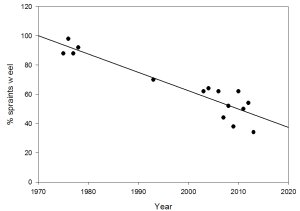 |
| Figure 2. Eel remains in Dinnet otter spraints, 2003-2013. Spearman Rank: rs=-0.865 n=15, P<0.01. (click for larger version) |
Eels that were taken also declined in size over the study period, from a calculated mean weight of 421g in 2003, to 305g in 2013, a decline of 28% (Fig. 3). The eel weight data are likely to be underestimates, due to the bias of under-estimation of the occurrence of larger vertebrae in spraints (Carss and Elston, 1996). Therefore the actual decline of eel size over the years is probably more pronounced.
Over the same period, the occurrence in spraints of fish species other than eels was relatively unimportant, but rose significantly (Fig. 4). When these other fish species were present in a spraint, this was usually in small quantities, e.g.as a single vertebra or a few scales.
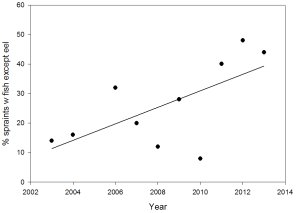 |
| Figure 4. Remains in spraints of fish other than eels, 2003-2013. Spearman rs=0.564 n=10, P<0.05. (click for larger version) |
Particularly striking was the increase in otter predation on birds (Fig. 5), many of the spraints in the later years containing nothing but feathers of small duckling, moorhen or coot. In 2011 one spraint contained remains of a goldeneye duckling (Bucephala clangula) that had been colour-marked with dye in a parallel study of that species in Dinnet (H. Scott, pers. com.). The increase in bird predation was especially steep during the last ten years. In the most recent years there were several observations of otter predation on adult greylag goose (Anser anser), young goslings, and adult teal (Anas crecca), from remains along the shores or tracks in snow.
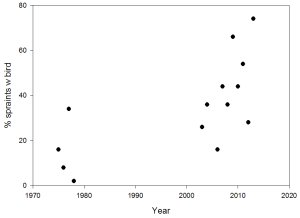 |
| Figure 5. Remains in spraints of birds (almost all juveniles), 2003-2013. Spearman rs=0.745 n=14 P<0.01 (click for larger version) |
Amphibians taken by otters in the Dinnet lochs were almost all frogs, and very few toads, despite the latter’s abundance (Weber, 1990). There was no significant long-term trend in the occurrence of amphibians in the otter diet, but considerable variation over the years (Fig. 6).
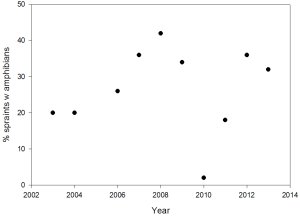 |
| Figure 6. Amphibians in Dinnet spraints, June 2003-2013. Spearman rs=0.157 n=10 p>0.05.(click for larger version) |
During the study period few mammals were taken by otters. This in contrast with the 1970s when they played an important role (Jenkins and Harper, 1980), but during the period 2003-2013 there was no obvious trend.
DISCUSSION
The declining numbers of otters in visual observation in the Dinnet lochs suggest a declining population, but one has to be mindful of the possibility of an increase in nocturnality of otters, with the decline of eel. Otters have been shown to be active especially at those times of day when their main prey species are inactive, as in Shetland (Kruuk et al., 1988). In the case of eels this is daytime. However, the few simultaneous observations of otter trails in reed beds, couches and numbers of spraint sites and spraints suggested that the lack of direct observations of otters was, indeed, largely due to their complete absence, rather than to their behaviour.
Results of otter faecal analyses have to be interpreted with care, because of the many hazards involved in spraint-data interpretation, which is plagued by large species- and size-specific biases (Carss and Parkinson, 1996, Carss and Elston, 1996). However, whatever the biases involved, the above results should be comparable between years and the trends shown in the above results should be reliable. There were significant declines in the otters’ use of eels as prey, and increases in the use of especially birds, but also of other fishes.
Eels have a higher calorific value than most other prey. Eels taken by otters were smaller at the end of the study period than earlier, and it has been demonstrated that small eels are calorifically less valuable to predators than are large ones (Nelson and Kruuk, 1997): the calorific content per gram of a 300g eel is more than 1½ x that of a 200g eel. Thus, our observations suggest a strong decline in energetic profitability of otter fishing, which is likely to have consequences for the population. It was predicted earlier that, at the present level of fishing profitability, otters would not be able to sustain numbers and reproduction (Kruuk, 2006). This study suggests that the Dinnet lochs have now reached that point.
Thus, the apparent changes in otter numbers in Dinnet are paralleled by a decline in their consumption of eel. There are no recent data on changes in the eel numbers in Dinnet itself, but the nearby Girnock Burn, a tributary to the River Dee, a decline of 50% was recorded over the last 30 years (ICES 2012). In Britain, and indeed worldwide, eel numbers show a spectacular decline, with recruitment in the 1990s a mere 1% of what is was in 1980 (Stone, 2003). There is a clear possibility of extinction in the next few decades. It is likely that these changes in eel numbers are paralleled in the Dinnet population.
Occurrence of ‘other fish’ in spraints increased significantly. However, within each spraint each of those other species usually showed only a minor presence, with only a few small vertebrae or small scales, and overall these ‘others’ were always of minor significance, as were invertebrates. The consumption of salmonids suggested that otters had been foraging in feeder streams or outlets of the lochs.
Effects of changes in otter diet on numbers of water birds are difficult to evaluate. Clearly there was a very steep increase in predation on birds per otter, especially after 2003, and remains of birds usually dominated entire spraints. However, the decline in otter numbers would have an opposite effect on overall predation. Numbers of ducklings of mallard (Anas platyrhynchos), widgeon (A. penelope) and tufted duck (Aythya fuligula) have declined in Dinnet over the last few years of the study period (H. Scott, pers. comm.). The long-term decline in mammals in the otter diet corresponds to a conspicuous decline of rabbits (Oryctolagus cuniculus) in and around the study area and elsewhere (unpubl. observations).
The profound ecological changes, in the Dinnet lochs over the last two decades, are of special conservation concern especially because of the apparent severe decline in otter numbers. Such changes in otter numbers are not likely to be detected in the national otter surveys in Britain, as these are based on the presence/absence of spraints, a measure which is not sensitive to changes in actual otter numbers (Kruuk, 2006).
If otter numbers are limited by food supply, as suggested from studies elsewhere and from the otters’ energetics (Kruuk et al., 1993, 1994; Kruuk and Carss, 1996; Kruuk, 2006), and if eel numbers in the lochs are or were of major importance to otters, then the changes in numbers of eels in the otter diet over the last decade provide a likely hypothesis for the steep decline in otter numbers and otter reproduction in Dinnet. One could argue that these declines have been detected in only this one study area, and may not be nationally representative. However, this is one of the longest and most intensive otter studies in Britain, and the decline in eel populations is probably nationwide (Stone, 2003). The present results, therefore, could well flag a national trend in otter numbers where eels were common, and should be of serious concern to conservationists.
Acknowledgements - This study has greatly benefitted from earlier fieldwork by colleagues, and from discussion with colleagues and students during the early years, especially with David Carss. I am also very grateful to Harry Scott for his contribution of observations, and to Gordon Woodroffe and Loeske Kruuk for comments on the manuscript.
REFERENCES
Anonymous (2013). River’s eel population soars 130-fold in a year. Cambridge News, 31 July 2013
Carss, D.N., Elston, D.A. (1996). Errors associated with otter Lutra lutra faecal analysis. II. Estimatung prey size distribution from bones recovered in spraints. Journal of Zoology, London, 238: 319-332.
Carss, D.N., Parkinson, S.G. (1996). Errors associated with otter Lutra lutra faecal analysis. I. Assessing general diet from spraints. Journal of Zoology, London, 238: 301-317.
Carss, D.N., Nelson, K.C., Bacon, P.J., Kruuk, H. (1998). Otter Lutra lutra prey selection in relation to fish abundance and community structure in two different freshwater habitats. Symposia of the Zoological Society of London, 71: 191-213.
Conroy, J.W.H., Watt, J., Webb, J.B., Jones, A. (1993). A guide to the identification of prey remains in otter spraint. Occasional Publications of the Mammal Society,16: 1-52.
ICES (2012). Report of the 2012 session of the Joint EIFAC/ICES Working Group on Eels. Copenhagen 3-9 September 2012. ICES CM 2007/ACFM, 23: 824 pp.
Jenkins, D.J. (1980). Ecology of otters in northern Scotland I. Otter Lutra lutra breeding and dispersion in mid-Deeside, Aberdeenshire in 1974-1979. Journal of Animal Ecology,
49: 713-735.
Jenkins, D.J., Burrows, G.O. (1980). Ecology of otters in northern Scotland III. The use of faeces as indicators of otter (Lutra lutra) density and distribution. Journal of Animal Ecology, 49: 755-774.
Jenkins, D.J., Harper, R.J. (1980). Ecology of otters in northern Scotland II. Analysis of otter (Lutra lutra) and mink (Mustela vison) faeces from Deeside, NE Scotland, in 1977-78. Journal of Animal Ecology,
49: 737-754.
Jenkins, D.J., Walker, J.G.K., McCowan, D. (1979). Analyses of otter (Lutra lutra) faeces from Deeside, NE Scotland. Journal of Zoology, London, 187: 235-244.
Kruuk, H., Nolet, B., French, D. (1988). Fluctuations in numbers and activity of inshore demersal fishes in Shetland . Journal of the Marine Biological Association, U.K.
68: 601-617.
Kruuk, H. (2006). Otters, ecology, behaviour and conservation. Oxford University Press, Oxford.
Kruuk, H., Balharry, E., Taylor, P.T. (1994). The effect of water temperature on oxygen consumption of the Eurasian otter Lutra lutra. Physiological Zoology,67: 1174-1185.
Kruuk, H., Carss, D.N., Conroy, J.W.H., Durbin, L. (1993). Otter (Lutra lutra L.) numbers and fish productivity in rivers in N.E. Scotland. Symposia of the Zoological Society of London, 65: 171-191.
Kruuk, H., Carss, D.N. (1996). Costs and benefits of fishing by a semi-aquati carnivore, the otter Lutra lutra L. In: Greenstreet, S., M Tasker M. (eds.). Aquatic predators and their prey, pp.10-17. Blackwell Scientific Publications, Oxford.
Nelson, K., Kruuk, H, (1997).
The prey of otters: calorific content of eels (Anguilla anguilla) and other fish, frogs (Rana temporaria) and toads (Bufo bufo).
IUCN Otter Specialist Group Bulletin, 14: 75-80.
Stone, R. (2003). Freshwater eels are slip-sliding away. Science,
301: 221-222.
Taylor, P.S., Kruuk, H. (1990). A record of an otter natal den. J. Zool., Lond. 222: 689-692.
Weber, J.-M. (1990). Seasonal exploitation of amphibians by otters (Lutra lutra) in north-east Scotland. Journal of Zoology, Lond., 220: 641-651.
Résumé : Loutres et Anguilles: Déclin en Ecosse .
Le régime alimentaire estival des loutres Lutra lutra a été étudié pendant presque 40 ans dans une zone au nord est de l’Ecosse. Depuis 2000, la population de loutres et leur succès reproducteur ont décliné. Simultanément l’occurrence des anguilles (Anguilla anguilla) dans les épreintes, initialement la proie principale des loutres, a diminué substantiellement. Ceci est considéré comme le reflet d’un net déclin global des anguilles.
La prédation des loutres sur les jeunes oiseaux dans la zone d’étude a augmenté ainsi que la prédation sur d’autres espèces de poisson, de même que l’importance relative des autres proies. Il est probable qu’avec cette restriction alimentaire chez les loutres, le déclin des anguilles représente un réel problème pour la conservation des loutres.
Revenez au dessus
Resumen: Nutrias y Anguilas: Observaciones de Largo Plazo Sobre Declinaciones en Escocia
Se ha monitoreado la dieta estival de nutrias Lutra lutra, por casi cuarenta años en un área de estudio en el NE de Escocia. Desde el 2000, la abundancia y reproducción de las nutrias en el área han declinado. Al mismo tiempo, disminuyó sustancialmente la ocurrencia de anguilas (Anguilla anguilla) en las fecas de nutrias; las anguilas eran anteriormente la presa dominante de las nutrias. Subyacente, hay una aguda declinación -bien documentada, en la abundancia de anguilas, y que probablemente sea global. En el área de estudio aumentó la predación de las nutrias sobre las aves acuáticas, así como sobre otras especies de peces, y también se documentan cambios en la importancia de otras presas. Se sugiere que al estar las nutrias limitadas por alimento, la declinación de las anguilas debería ser una seria preocupación para los involucrados en la conservación de las nutrias.
Vuelva a la tapa
